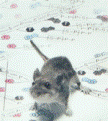Papers in the Biological Sciences

Jay F. Storz Publications
Document Type
Article
Date of this Version
9-2013
Citation
Published in Evolution (Early View), doi: 10.1111/evo.12257
Abstract
In species that are distributed across steep environmental gradients, adaptive variation in physiological performance may be attributable to transcriptional plasticity in underlying regulatory networks. Here we report the results of common-garden experiments that were designed to elucidate the role of regulatory plasticity in evolutionary adaptation to hypoxic cold-stress in deer mice (Peromyscus maniculatus). We integrated genomic transcriptional profiles with measures of metabolic enzyme activities and whole-animal thermogenic performance under hypoxia in highland (4350 m) and lowland (430 m) mice from three experimental groups: (1) wild-caught mice that were sampled at their native elevations; (2) wild-caught/labreared mice that were deacclimated to low-elevation conditions in a common-garden lab environment; and (3) the F1 progeny of deacclimated mice that were maintained under the same low-elevation common- garden conditions. In each experimental group, highland mice exhibited greater thermogenic capacities than lowland mice, and this enhanced performance was associated with upregulation of transcriptional modules that influence several hierarchical steps in the O2 cascade, including tissue O2 diffusion (angiogenesis) and tissue O2 utilization (metabolic fuel use and cellular oxidative capacity). Most of these performance-related transcriptomic changes occurred over physiological and developmental timescales, suggesting that regulatory plasticity makes important contributions to fitness-related physiological performance in highland deer mice.
6 supplemental files are attached below.
Table S1. Average log-2 counts per million reads (logCPM), likelihood ratio statistics (LR), uncorrected (P), and Benjamini– Hochberg corrected (FDR) P values for genes with significant treatment effects.
Storz EVOLUTION 2013 Functional genomics-sup-0002-TableS2.xlsx (71 kB)
Table S2. Average log-2 counts per million reads (logCPM), likelihood ratio statistics (LR), uncorrected (P), and Benjamini– Hochberg corrected (FDR) P values for genes with significant population effects.
Storz EVOLUTION 2013 Functional genomics-sup-0003-TableS3.xlsx (96 kB)
Table S3. Modules of correlated transcripts with significant treatment effects. Degree refers to the average correlation of a transcript with all other transcripts in the module.
Storz EVOLUTION 2013 Functional genomics-sup-0004-TableS4.xlsx (56 kB)
Table S4. Modules of correlated transcripts with significant population effects. Degree refers to the average correlation of a transcript with all other transcripts in the module.
Storz EVOLUTION 2013 Functional genomics-sup-0005-TableS5.xlsx (48 kB)
Table S5. Apparent Vmax for enzymes in the gastrocnemis muscle of highland (HA) and lowland (LA) deer mice in each of the 3 experimental groups.
Storz EVOLUTION 2013 Functional genomics-sup-0006-FigureS1.tiff (1521 kB)
Figure S1. Diagram of respirometry setup


Comments
Copyright © 2013 Zachary A. Cheviron, Alex D. Connaty, Grant B. McClelland, and Jay F. Storz. Published by Wiley-Blackwell. Used by permission.